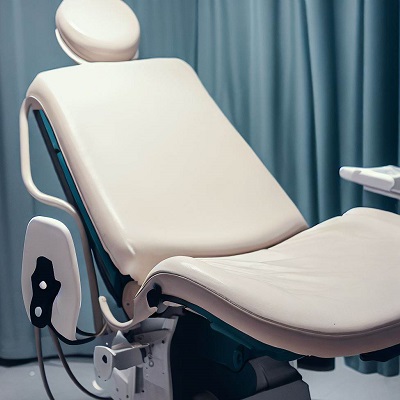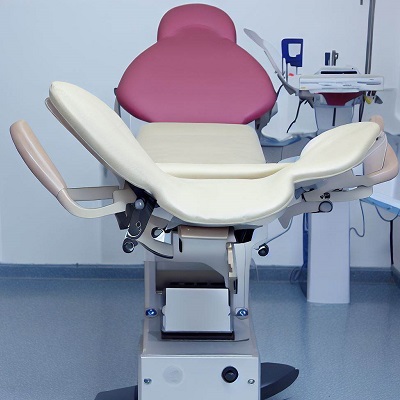Today I will move on to the new ideas as follow.
Patient comfort is important during gynecologic exams because it can affect the patient's physical and emotional well-being. A gynecologic exam can be an uncomfortable and sometimes painful experience for the patient. If the patient is not comfortable during the exam, it can cause physical discomfort and even pain. This can lead to the patient avoiding future exams or delaying necessary follow-up care.
In addition to physical discomfort, a lack of patient comfort can also cause emotional distress. Many patients may feel embarrassed or anxious during a gynecologic exam, which can be exacerbated if they feel uncomfortable or unsupported. This can lead to the patient feeling stigmatized or ashamed, which can negatively impact their mental health and future care-seeking behavior.
Ensuring patient comfort during gynecologic exams can help to improve patient experiences and promote better health outcomes. Practices that prioritize patient comfort, such as explaining the steps of the exam, providing a comfortable environment, and offering emotional support, can help patients feel more at ease and empowered. This can help to increase patient trust and satisfaction, as well as encourage patients to seek out necessary care.

These may include:
1. Stress and anxiety - Many patients may experience anxiety and stress leading up to the exam, especially if they fear a negative result or have experienced trauma related to gynecological care.
2. Embarrassment and Shame - Gynecological exams can be intimate and invasive, leading patients to feel embarrassed or ashamed about their bodies or their experiences.
3. Fear of pain or discomfort - The exam itself may be uncomfortable or painful, which can lead patients to dread or avoid necessary exams or screenings.
4. Trust and control issues - Patients may struggle to trust their doctor or healthcare provider during the exam, particularly if they feel like they have little control over their experience.
5. Negative emotions after the exam - Patients may experience a range of negative emotions, such as fear or sadness, after the exam, particularly if they receive a difficult diagnosis or treatment plan.
These psychological challenges can have a profound effect on patients, and may lead some to avoid gynecological care or delay important screenings and treatments. Healthcare providers can help patients overcome these challenges by providing a patient-centered care approach, including open communication, emotional support, and a focus on patient comfort and empowerment.
1. Communicate effectively: A clear, concise explanation of the exam and its purpose can help ease anxiety and establish trust between the healthcare provider and the patient. It's important to use non-judgmental language and to confirm the patient's understanding of the exam.
2. Be Empathetic and patient-centered: Understanding that each patient is unique and may have different fears or concerns is crucial. Taking time to listen to their thoughts and concerns and be empathetic can go a long way in making the experience more comfortable.
3. Offer privacy and modesty: Providing privacy and adequate gowns can make the process more comfortable and less intimidating for patients. Providers should always knock before entering and give the patient time to change.
4. Promote patient comfort: Encourage patients to communicate any discomfort during the exam. Using distraction techniques or allowing patients to insert the speculum on their own can help them feel more in control.
5. Inform the patient about the exam phases: informing patients about each aspect of the exam and what to expect can reduce uncertainty and stress.
6. Minimize Pain: Providers can minimize pain by using the right size of speculum and lubrification, and taking adequate time during the exam.
7. Encourage Questions: Encouraging patients to ask questions about the exam and providing clear answers can help alleviate fear or embarrassment.
8. Offer follow-up support: Patients may feel vulnerable or emotional after an exam, offering follow-up resources or support can help them cope with a difficult result.
By implementing these tips, healthcare providers can help create a more comfortable and less intimidating experience for their patients during gynecological exams.
Here are some of the different types of features that modern chairs offer:
1. Adjustable Positions: Many modern chairs come with multiple adjustable positions, such as reclining backrests, adjustable armrests, and leg rests. These positions can help patients find the most comfortable position for their body, and help distribute pressure more evenly throughout their body.
2. Padded Surfaces: A padded surface on a chair provides additional cushioning and support to the patient's body, which can help reduce the risk of pressure sores, muscle strains, and other discomfort. Padded surfaces are often made of materials like foam, gel, or memory foam, which can conform to the patient's body shape and offer better pressure relief.
3. Thigh Supports: Some modern chairs come with thigh supports that can be adjusted to provide additional support and comfort for patients with certain medical conditions, such as hip or knee problems. Thigh supports help distribute pressure more evenly throughout the legs, and can help reduce discomfort and pain.
4. Lumbar Support: Lumbar support refers to additional support for the lower back region. Lumbar supports can be integrated into the chair's design or added as a separate accessory. They are especially helpful for patients who need to sit for long periods of time, as they can help maintain proper spinal alignment and reduce the risk of back pain.
5. Armrests: Armrests can provide additional support and comfort for patients, especially those who need to spend prolonged periods sitting in a chair. Some modern chairs offer adjustable armrests that can be moved up or down to accommodate the patient's height and arm length.
Overall, modern chairs have come a long way when it comes to offering different features to improve patient comfort. By incorporating adjustable positions, padded surfaces, thigh supports, lumbar support, and armrests, they can help patients prevent discomfort, reduce pain, and maintain proper posture while seated.

1. Improved Workflow: The new design of gynae chair has improved the workflow for healthcare providers as they can now work more efficiently. For example, the adjustable positions available make it easier for providers to access the patient's genitalia, which can improve the accuracy of the examination. This means that healthcare providers can diagnose and treat patients faster and more accurately.
2. Reduced Physical Strain: The new gynecologic chairs are designed to reduce physical strain on healthcare providers. For example, the adjustable and ergonomic features can help prevent back pain or strain associated with prolonged standing or awkward postures.
3. Improved Patient Comfort: The improved design and added features of modern gynecologic chairs have also helped improve patient comfort, which in turn has made it easier for healthcare providers to perform their duties. By having patients more comfortable and relaxed, healthcare providers can perform procedures more effectively and with less resistance from the patient.
4. Increased Patient Satisfaction: The increased comfort provided by modern gynecologic chairs has also led to increased patient satisfaction, which can impact healthcare providers positively. Satisfied patients are more likely to return for follow-up care, recommend the healthcare provider to others, and have a better overall experience with their medical care.
5. Increased Safety: The new design of gynecologic chairs has also improved patient safety. Features like adjustable stirrups and padded surfaces can prevent injuries to patients during procedures, which can also reduce liability and legal issues for healthcare providers.
In summary, the improved design of gynecologic chairs has positively impacted healthcare providers by improving workflow, reducing physical strain, improving patient comfort and satisfaction, increasing safety, and ultimately providing better care for patients.
Ergonomic improvements to the chair's design have led to reduced physical strain and workplace injury for healthcare practitioners in various ways. Firstly, the use of adjustable armrests and backrests ensures that healthcare practitioners can maintain proper posture while working, which reduces strain on their back, shoulders, and neck.
Secondly, the use of height-adjustable chairs allows healthcare practitioners to adjust the height of their chair to suit the level of the patient, which not only reduces strain on the practitioner's body but also minimizes the need for awkward movements and postures such as bending or twisting, which can cause musculoskeletal injuries.
Thirdly, chairs with lumbar support are specifically designed to support the lower back. This is important for healthcare practitioners who spend long hours sitting, as it helps to prevent lower back pain and reduces the risk of developing musculoskeletal disorders.
Overall, ergonomic improvements to chairs used by healthcare practitioners have greatly reduced the incidence of physical strain and workplace injury, and this has resulted in a more comfortable and efficient workplace environment.
1. Take breaks: Taking short breaks during the workday can help to reduce fatigue and prevent muscle strain. Healthcare providers should aim to take a break every 60 to 90 minutes.
2. Use proper body mechanics: Healthcare providers should use proper body mechanics when they are lifting or moving patients. This includes keeping their back straight, bending at the knees and hips, and avoiding twisting.
3. Use proper footwear: It is important for healthcare providers to wear comfortable, supportive footwear that provides good traction. Proper footwear can help to reduce the risk of slips, trips, and falls, which can cause workplace injuries.
4. Stretch before and after work: Stretching before and after work can help to loosen up tight muscles and prevent muscle strain.
5. Use ergonomically designed equipment: Healthcare providers should use ergonomic equipment such as adjustable obgyn exam tables and chairs with lumbar support to reduce physical strain and prevent workplace injuries.
6. Maintain a healthy lifestyle: Maintaining a healthy lifestyle by eating a healthy diet and exercising regularly can help to improve strength and flexibility, thereby reducing the risk of workplace injuries.
By following these tips, healthcare providers can maximize their own comfort during exams while minimizing the risks of workplace injuries.

To sum up, the main topic points discussed in this article focused on the importance of comfortable gynecological chairs for both patients and healthcare providers. The article highlighted how gynecological chairs have evolved over time to become more comfortable and convenient, considering the needs of both patients and healthcare providers. The design of modern gynecological chairs incorporates ergonomic features such as adjustable heights, comfortable padding, stirrups, armrests, and easy patient access to make the exam process more comfortable and relaxing for the patients.
Furthermore, the article also emphasized the importance of healthcare providers taking measures to maximize their own comfort during exams while minimizing the risk of workplace injuries. By taking breaks, using proper body mechanics, wearing appropriate footwear, stretching before and after work, using ergonomic equipment, and maintaining a healthy lifestyle, healthcare providers can optimize their comfort while providing the best possible care to their patients.
In conclusion, the design of gynecological chairs have progressed over time to become more patient and healthcare provider friendly. These improvements in design and focus on comfort can lead to more efficient and effective healthcare practices, making the experience of exams less stressful for patients and healthcare providers.
Overall, it is essential to prioritize patient comfort and reduce workplace injuries for healthcare practitioners in order to provide positive healthcare experiences for everyone. By focusing on patient comfort, healthcare providers can create a more relaxing and comfortable environment, leading to improved patient satisfaction and overall health outcomes. Likewise, reducing workplace injuries can enhance the overall well-being of healthcare providers, allowing them to perform their duties more effectively while avoiding burnout and injury. Ultimately, prioritizing these aspects of healthcare can lead to improved healthcare experiences for everyone involved, making for a healthier and happier community.